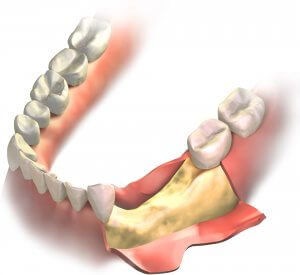What is a bone graft, and why might you need one? Bone grafts are sometimes required before you get dental implants or some other forms of restorative dentistry. This surgical procedure is usually done when the jaw bone is too weak for the placement of a dental implant.
A bone graft is a serious procedure no matter where it is on your body, and an oral bone graft is no exception. Bone grafting may sound like a scary and painful procedure, but it doesn’t have to be, and it can certainly be worth it in the long run. So, let’s get into the nitty-gritty of jawbone grafts and find out what it entails.
In This Article
Bone grafts
A bone graft is most often used in restorative dentistry to bulk up the jawbone before having implant surgery. After significant trauma, infection, disease, or an extended period of time without teeth, your jawbone may need restoration before a tooth implant procedure. That’s because your jaw can actually lose some of its density, making it unfit for implantation. That’s where a bone graft comes in; grafts are a way to build your bone up, by inserting bone taken from another place in your body, or even another body.
Dental bone graft material
There are many different materials used for bone grafting but they can generally be divided into three categories:

- Allograft: Bone that is harvested from a human donor or cadaver for use in medical procedures
- Autograph: Bone that is harvested from another area of the patient’s body.
- Alloplastic: Usually is made from hydroxyapatite or calcium carbonate, both naturally occurring minerals.
There are other materials that can be used in a bone grafting procedure; such as bone tissue from another species (like a cow) and synthetic variants. The pricing of your surgery is highly dependent on the type of materials used.
A consultation with your oral and maxillofacial surgeon is the first step to determining where the bone grafting material will come from. Most dental grafting procedures involve a combination of autogenous bone or autograft (bone that is harvested from another area of the patient’s body), allografts (bone from a bone bank) or xenografts (bone from another animal).
If your doctor decides that an autograft is appropriate, it is likely that the bone graft will come from another part of the jawbone. If a large quantity of bone is needed then bone may also be obtained from the hip, or lower leg. There are two main reasons for this: the quantity of bone available in those areas and the convenient access for the procedure.
Autograft is often seen as the ideal way to go for jaw bone graft patients because it stimulates bone growth with live bone cells. Other graft materials are used with autografts to increase the volume of the graft and make it more stable over time. Of course with an autograft you will have a second wound that needs to heal following surgery.
Bone graft surgery
Apart from materials, bone grafting can be classified according to whether it’s major or minor surgery as well. Teeth bone grafting can be a very invasive and major surgery depending on the level of bone loss, or the severity of the gum disease. The state of your jawbone will determine which type you will need. Jawbone graft surgery typically lasts 45 minutes to an hour. Check out this video to see how the surgery works!
Tooth extraction and bone graft
A tooth extraction bone graft may be necessary before dental implant surgery. This is especially true if gum disease has affected your natural teeth to the point of needing extraction and dental implants. Not all patients require surgery before getting dental implants. But there are some patients who will require transplanted bone to prevent bone loss and aid in bone growth prior to dental implant surgery.
Bone grafting for tooth implants is very common, but teeth bone grafts are also popular in the treatment of gum disease that has progressed down to the jawbone. Your healthcare provider may suggest a bone graft as a solution to periodontal disease that has penetrated the gums and made its way into the jaw bone.
Other types of graft procedures

Socket graft
A bone graft for dental implants is necessary if after a tooth is removed, the surrounding bone is weak and susceptible to decay. This type of bone grafting for a tooth implant is called a socket graft and it is typically performed after a tooth is extracted. This is because the body will gradually resorb the bone unless it is replaced with either a graft or an implant. It consists of natural bone material and is added into the space left by tooth extraction. Usually, this type of grafting will heal in six months and then an implant can be placed.
Block bone graft
Block bone grafts are a type of bone graft after tooth extraction that is usually needed if the site isn’t immediately treated with a socket graft. Another cause of severe bone loss requiring surgery is gum disease. Gum disease, injury, and significant trauma can all result in such bone and tooth loss that a block bone graft may be the best way to rebuild the bone. A small piece of bone tissue is removed from another area of the jaw bone, set in place, then secured with screws. After several months of healing from the transplanted bone procedure, the body will be ready for dental implant surgery.
Sinus Lift and bone graft
A sinus lift is a kind of dental surgery that may accompany a bone graft for dental implants. If there is insufficient bone availability on the upper jaw, placement of implants may interfere with the sinus cavity above. In this case, an oral surgeon will access the sinus cavity and lift it up before placing the bone graft below. Then, there is no risk of damage to the sinuses when the implant is placed, around four months later when the area has healed.
Dental bone grafts complications
Before your grafting procedure, it is important to discuss possible dental bone grafting complications with your healthcare provider. Possible complications for the procedure include:
- Rejection: The donor grafts are not accepted by the patient’s body and are rejected; the body pushes out what it sees as a foreign object instead of fusing with it and growing new bone.
- Infection: If the procedure is done in a contaminated environment or there isn’t proper aftercare to ensure the site of the bone grafts is clean, then risk of infection increases.
Dental bone grafts recovery
Dental bone graft recovery is typically an outpatient procedure, meaning you don’t need to be admitted to the hospital, instead, you can heal at home. Tooth bone grafting does, however, require a significant amount of healing time. But, considering that you’re essentially adding another piece of bone to your jawbone and getting it to fuse together into a new bone, six months healing time isn’t so bad.
What to expect
After your grafting surgery has taken place, the initial recovery period will be about two weeks. During this time you may experience several things:
Day of surgery
- Bleeding: There will be a lot of bleeding and it is important to change out the bandages at the site of the procedure often.
- Swelling: There is likely to be some swelling as well. Depending on the severity of the operation the swelling can affect more than just your mouth, including your cheeks, eyes, and the side of the face. Ice packs are a good way to bring down the swelling and ease the pain associated with it.
- Pain: This procedure can result in some pain and discomfort. The good news is that you will most likely be prescribed painkillers to help with the pain while you are healing.

Some things that your healthcare provider will go over with you before sending you home include:
Two weeks after surgery
- Antibiotics: Your healthcare provider may prescribe you antibiotics after the operation. It is important that you take them as prescribed and finish the whole dosage. Infection is a common complication.
- Diet: For the first few weeks you will be eating like a baby, meaning only soft foods and liquids are allowed. Dairy is not recommended as it contains live bacteria that can harm the surgery site.
- Oral Hygiene: After the operation, you will need to take some special steps to keep your mouth clean. Your doctor will give you instructions. They may include rinsing your mouth out with a mouthwash prescribed by your doctor twice or more a day. Keeping your mouth clean while it is healing is incredibly important.
After the healing process from the bone graft procedure is finished, the patient can go in for dental implant surgery. This surgery has an additional recovery time, costs, and other complications and risk factors. As always check with your healthcare provider about your particular needs.
Dental bone graft cost
Finally, the big question: How much do dental grafts cost? Bone graft costs can range from $200 to $3,000 depending on the materials used for the graft. Dental implants are not included in this cost. The table below does not include costs with different insurance plans.
Material | Cost |
Patient's own | $2,000–$3,000 |
Cadaver bone | $2,000–$1,200 |
Bovine bone | $300–$800 |
Synthetic bone | $250–$1,100 |
A dental insurance plan may cover part of your treatment costs. We know that dental insurance can be expensive and it can also be difficult to know which plan to choose.
But we are here for you — we’ve created a special comparison tool that shows you the top plans in your area to help guide you in your decision.
It takes just a few seconds to fill in your DOB and zip code, and you’ll see full coverage plans that cover your needs. Get started with the form below!

Conclusion
A bone graft is used in restorative dentistry to bulk up the jawbone before having implant surgery. The process involves taking material from either the patient’s body, a cadaver, cows, or synthetic sources and placing it in the jawbone to fuse with the original bone. There are several types: block bone graft, socket graft, and sinus lift. Each one has it’s own purpose and recovery period.
This type of surgery can be painful and result in swelling and bleeding, requiring a special regimen afterward to promote healing and minimize infection. The recovery time is about six months and depends on the severity of the procedure.
All surgeries include risk of complications, this one is no different and comes along with the risk of rejection and infection. Depending on the material used in the grafting procedure, the cost can go up to $3,000 or be as low as $200. Make sure to check with your personal insurance provider to find out about cost-effective options.
FAQs
Can your body reject a bone graft?
Yes, it is possible for your body to reject a bone graft. To minimize the risk of rejection, the patient can opt to use material from their own body or a human donor.
Is a bone graft painful?
Yes, a bone graft is an invasive surgery and as such, is painful. However, you will receive dental sedation during the procedure and your doctor will prescribe painkillers for the recovery period.
How long does it take to recover from a bone graft?
Every patient is different, and each procedure is unique. The recovery period for a dental bone graft can range from two to eight months depending on the specific procedure.
What is a bone graft made of?
A bone graft is not always human bone. A bone graft can be made of bone from the patient, bone from a human donor, a bone from an animal, or synthetic materials.
Mayo Clinic: Dental Implant Surgery. Consulted 19th, April 2020.
NCBI: Bone Grafts in Dentistry. Consulted 19th, April 2020.
NCBI: Socket grafting: a predictable technique for site preservation. Consulted 19th April 2020.
NCBI: The rate and stability of mandibular block bone graft in recent years. Consulted 19th April 2020.




